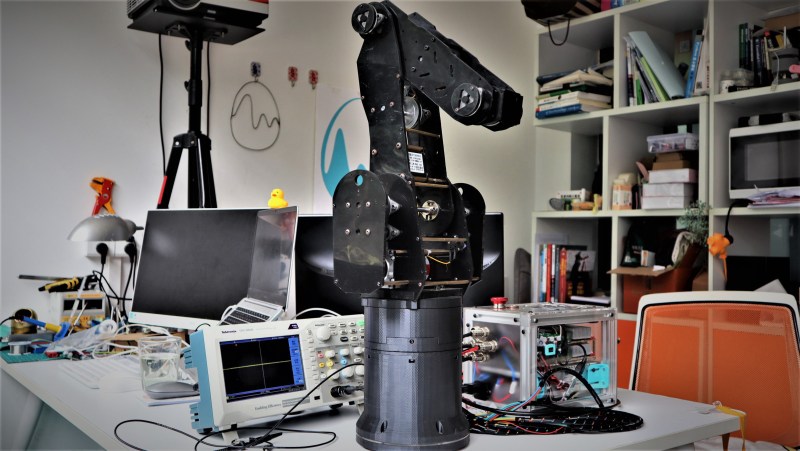When Iron Man movie came out, we’d bet there wasn’t a single hacker that left the theater without daydreaming about having a few robotic lab assistants of their own. But unlike most of them, [Tony-Lin] decided to turn his celluloid dreams into a reality and started work on his robotic arm, Abot.
Abot is built from a combination of 5 mm nylon panels and 3D printed parts. One thing we found particularly interesting about this build is that the motor reductions for the joints are done using stages of pulleys and GT2 belting rather than planetary gear boxes or cycloidal drives. This produces a lightweight and affordable build.
He also designed his own driver boards for each motor using the STM32. They communicate with a CAN bus which uses USB connectors, an interesting choice. Just make sure not to try and charge your phone with it.
We have to admit to a little jealousy that [Tony] is moved himself a bit closer to being Tony Stark than the rest of us are likely to get. We’ll just have to live vicariously through the documentation of his project.



















Well I’m grinding away here still with a Robotron and an ATTiny85… managed to get some speech recognition crammed into that so it can blink a light when I say “Jarvis” but TBH it’s super primitive phoneme based and flashes the light if I say “armpits” also. Just got a couple of bytes left to cram in all the motor control and feedback sensing etc etc…
derp an Armatron not some eastern bloc box or a cult game.
Robotron was a very very good game. Choose your words carefully! :)
I wonder what Alexa hears when you say “armpits” though. You might be surprized how un-unsophisticated your project is.
I’m super aware that that is unsophisticated, thought that the ATTiny85 was an obvious walnut to crack a sledgehammer situation. Though you can get some really tight characterisation of data for 2 or 3 small phonemes so not beyond the bounds of possibility you could cram a simple forward, back, stop type implementation for a toy in one.
Though back in the day, I had a setup with an Amiga (parallel port sampler for input) that worked pretty well for about 200 learned words, and that didn’t take up a whole lot of RAM and storage, so given that an AVR outMIPs a 68000, something like an Arduino Mega might well be enough to do something “real” with.
The Jasper project looks like the best way to go for plug together cloudless speech recog these days. I’m gonna have to look up what system was used in older Nokia phones, I found it quite accurate, I know others didn’t. I keep feeling that there’s been some patent encumbrance (Of the overly broad type) for desktop and offline speech recog the past couple of decades, it might be about to burst wide open.
I will not be tempted down the cloud path. IMO all collections of personal data are insecure, because in their accumulation, they reach a point, where payoff in ID theft and fraud, etc, or temptation for various security services gets great enough that they are worth “investing” a million to compromise. Shareholders are only going to allow security expenses in proportion to the legal value of the data to their company (Probably only in terms of the next few quarters, not 5 year value of loyalty/retention etc) not the illegal value, so there comes a point whether through blackhattery, bribery, social engineering, or whatever that that data will be compromised.
Funnily enough, one of the creators of Robotron is named Jarvis.
Wouldn’t mind seeing a video. There are loads of nice looking robot arms, but some are a little slow and shaky for my liking. This one looks great though! Fingers crossed
Agreed, this is a neat design I’d like to see some more of. If its a bit shaky in the structure its not hard to iterate in some more bracing.
My doubt with this method is not it being slow or shaky though, but not being able to carry any load at all. There is a reason most arms are slow and that is the torque needed just to hold the arms own weight let alone have it doing something is beyond the reasonably sized and priced motors without serious gearing down.
Could also start getting belt jumps if it does move any load quickly – but that is something easy to mitigate in software with nice PID loops for gradual accelerations.
This is basically a copy of a copy of a copy of a copy of an arm that came out in at least the 80’s, maybe even the 70’s. The use of the belts in this arrangement is nothing new, nor is the design of this bot. There are also a few commercial versions of practically identical bots available right now and plenty of info out there to build your own which this may be based on. Cant say there is anything particularly special here other than motivation.
Nice execution. The only concern I have is that nylon is pretty hydroscopic, and dimensional changes are notable at extremes of humidity. Normally this isn’t much of a problem, but the torque transmission performance of those fine pitch belts is pretty sensitive to the sprocket spacing. A 0.5 mm change in center distance on any two sprockets is likely to lead to a belt skip, particularly on those smaller sprockets.